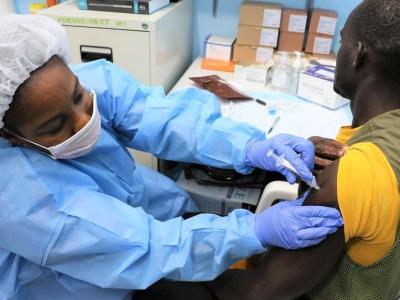April 13, 2005 (CIDRAP News) – Tests on poultry in Vietnam's Mekong Delta region show the H5N1 avian influenza virus is remarkably widespread, a finding that may bolster experts calling for a shift from culling to vaccinating birds.
Seventy-one percent of samples from ducks and geese in the Mekong Delta have tested positive for the presence of the lethal virus, the Associated Press (AP) reported today. Twenty-one percent of chickens were found to carry the virus as well.
The study involved samples from more than 10,000 geese and ducks from farms in 10 provinces, but the number of chickens tested was not reported.
Ba Thanh Nguyen, director of the Can Tho regional animal health center, told reporters that investigators don't yet know the impact of the findings.
"We still don't know how strong the virus is. It may kill or may not kill the poultry," Nguyen said in the AP story. "But it shows that the virus is entrenched in the region."
The results suggest that more than half of the roughly 20 million poultry in the region should be culled to halt the spread of the virus, Nguyen said. Culling has been Vietnam's chief response to stem the spread of H5N1.
However, many farmers are simply refusing to cull their flocks, the AP reported. The Vietnamese government is offering to pay 32 to 64 cents for each culled bird, a far cry from the market price of $1.30 to $1.90 per bird.
The "extremely high" amounts of virus in the Mekong Delta region and the farmers' reluctance to kill their birds underscore the region's complex problems with H5N1, said Dave Halvorson, DVM, an extension veterinarian in avian health at the University of Minnesota and a professor in the Veterinary Biomedical Sciences Department in St. Paul.
"You can't expect farmers to give up their birds at 50 cents on the dollar," he told CIDRAP News. "When you're dealing with people whose incomes may be $5 or $6 a day, how do you motivate them to give up their livestock? It's not possible."
"H5N1 is going to be in East Asia for a long time," he said. "What's required to get rid of it is probably beyond the means of the countries involved."
To effectively fight the virus, the Vietnamese government would need to be able to pay market rates for culled poultry, disinfect affected farms, and replace the food lost through culling, Halvorson said.
Halvorson and other experts also emphasize the possible role of immunization in fighting the disease. "I anticipate there will be more and more vaccination," he said.
Nature published a news story online today that cites a number of avian flu experts who prefer immunization over culling. Producers have been reluctant to immunize because it can jeopardize a country's poultry exports.
In Paris last week, participants in a joint conference of the United Nations Food and Agriculture Organization (FAO) and the World Organization for Animal Health (OIE) concluded that mass culling as the main means of control is no longer acceptable "for ethical, ecological, and economic reasons."
"This is a massive change in policy," said Robert G. Webster, PhD, director of the World Health Organization (WHO) Collaborating Center for Studies on the Ecology of Influenza in Animals and Birds, as quoted in the April 14 issue of Nature. Because of the interplay of wild and domestic poultry and the extent of H5N1 virus, it could continue to reappear, the article said.
Participants in the Paris meeting also called for $100 million to $120 million in aid over the next 3 to 5 years to assist poorer countries in developing vaccination programs.


















